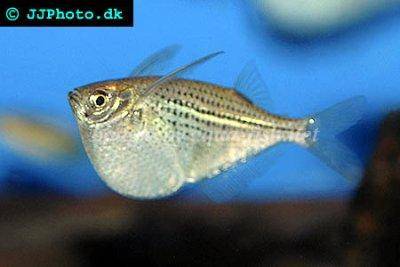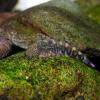Common hatchetfish - Gasteropelecus sternicla
Scientific name: Gasteropelecus sternicla
Common name: Common hatchetfish
Family: Gastromyzontidae
Usual size in fish tanks: 6 - 7 cm (2.36 - 2.76 inch)
014
Recommended pH range: 5.5 - 7.5
Recommended water hardness: 4 - 12°N (71.43 - 214.29ppm)
0°C 32°F30°C 86°F
Recommended temperature range: 24 - 28 °C (75.2 - 82.4°F)
The way how these fish reproduce: Spawning
Where the species comes from: South America
Temperament to its own species: peaceful
Temperament toward other fish species: peaceful
Usual place in the tank: Top levels
Food and Feeding
The Common Hatchetfish (Gasteropelecus sternicla) is a carnivorous species, feeding on small insects, worms, and other tiny invertebrates in the wild. In captivity, they will readily accept a variety of foods, including high-quality flake food and small live or frozen foods like brine shrimp and bloodworms. To replicate their natural diet and keep them healthy, it’s important to offer them protein-rich treats 2-3 times a week. Because these fish primarily feed from the water's surface, be sure to provide floating food or food that will stay at the surface for an extended period.
Origin
The Common Hatchetfish (Gasteropelecus sternicla) is native to South America, specifically in the slow-moving rivers and streams of Brazil, Guyana, and Suriname. They are often found in areas with dense vegetation and overhanging plants, which provide them with protection and easy access to their natural food source of insects.
Sexing
Sexing Common Hatchetfish can be difficult, but there are subtle differences between males and females. Males tend to be slightly slimmer and smaller compared to females, who develop a rounder, plumper appearance, especially when carrying eggs. During breeding times, this distinction becomes more apparent as the females fill with eggs.
Breeding
Breeding Common Hatchetfish in captivity can be challenging but is possible with the right conditions. In the wild, breeding usually begins during the rainy season. To encourage spawning in the aquarium, replicate the rainy season by slightly lowering the water temperature and performing frequent water changes with soft, acidic water. The female will scatter her eggs near floating plants or in vegetation, and the male fertilizes them by releasing sperm nearby. The eggs are usually adhesive and will attach to the plants. Once hatched, the fry can be fed newly hatched brine shrimp or infusoria.
Lifespan
With proper care, Common Hatchetfish can live up to 5 years in captivity. Keeping the water clean, maintaining stable water parameters, and providing a varied diet are essential to ensuring they reach their full lifespan.
General Care
Common Hatchetfish are peaceful and generally get along well with other community fish, as long as they are housed with similarly sized, non-aggressive species. However, they are known for their remarkable jumping abilities, which they use in the wild to catch flying insects just above the water surface. To prevent them from jumping out of the aquarium, it’s crucial to keep the tank covered with a tightly fitting lid and maintain a slightly lower water level to accommodate their jumping behavior.
These fish prefer a well-planted aquarium with floating plants, which help replicate their natural habitat and provide cover. They thrive in soft, slightly acidic water with a temperature range of 24-28°C (75.2-82.4°F) and a pH range of 5.5-7.5. Water hardness should remain between 4-12°N (71.43-214.29ppm). Since they are surface dwellers, they need calm water with minimal surface disturbance, so avoid using high-powered filtration systems that cause strong currents.
Short Description
Gasteropelecus sternicla, commonly known as the Common Hatchetfish, is a small, peaceful species that spends most of its time at the water’s surface. Known for their distinctive hatchet-shaped bodies and remarkable ability to leap out of the water, these fish use their jumping skills to catch flying insects in the wild. In the aquarium, they require a tightly covered tank and floating plants to provide cover and reduce stress. Common Hatchetfish are well-suited to peaceful community tanks with soft, acidic water conditions.
Pictures
Bought by aqua-fish.net from jjphoto.dk



 Spiney-headed
Spiney-headed